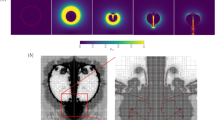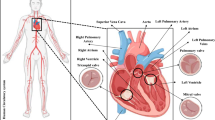Abstract
Working mechanisms of the cardiac defibrillation are still in debate due to the limited experimental facilities and one-third of patients even do not respond to cardiac resynchronization therapy. With an aim to develop a milestone towards reaching the unrevealed mechanisms of the defibrillation phenomenon, we propose a bidomain based finite element formulation of cardiac electromechanics by taking into account the viscous effects that are disregarded by many researchers. To do so, the material is deemed as an electro-visco-active material and described by the modified Hill model (Cansız et al. in Comput Methods Appl Mech Eng 315:434–466, 2017). On the numerical side, we utilize a staggered solution method, where the elliptic and parabolic part of the bidomain equations and the mechanical field are solved sequentially. The comparative simulations designate that the viscoelastic and elastic formulations lead to remarkably different outcomes upon an externally applied electric field to the myocardial tissue. Besides, the achieved framework requires significantly less computational time and memory compared to monolithic schemes without loss of stability for the presented examples.










Similar content being viewed by others
References
Abraham WT, Fisher WG, Smith AL, Delurgio DB, Leon AR, Loh E, Kocovic DZ, Packer M, Clavell AL, Hayes DL, Ellestad M, Trupp RJ, Underwood J, Pickering F, Truex C, McAtee P, Messenger J (2002) Cardiac resynchronization in chronic heart failure. N Engl J Med 346:1845–1853
Abraham WT, Hayes DL (2003) Cardiac resynchronization therapy for heart failure. Circulation 108:2596–2603
Aliev RR, Panfilov AV (1996) A simple two-variable model of cardiac excitation. Chaos Solitons Fractals 7:293–301
Augustin CM, Neic A, Liebmann M, Prassl AJ, Niederer SA, Haase G, Plank G (2016) Anatomically accurate high resolution modeling of human whole heart electromechanics: a strongly scalable algebraic multigrid solver method for nonlinear deformation. J Comput Phys 305:622–646
Bleeker GB, Bax JJ, Steendijk P, Schalij MJ, van del Wall EE (2006) Left ventricular dyssynchrony in patients with heart failure: pathophysiology, diagnosis and treatment. Nat Clin Pract Cardiovasc Med 3:213–219
Bragard J, Elorza J, Cherry EM, Fenton FH (2013) Validation of a computational model of cardiac defibrillation. Comput Cardiol 2013:851–854
Cansız B, Dal H, Kaliske M (2015) Fully coupled cardiac electromechanics with orthotropic viscoelastic effects. Proc IUTAM 12:124–133
Cansız B, Dal H, Kaliske M (2017) Computational cardiology: A modified Hill model to describe the electro-visco-elasticity of the myocardium. Comput Methods Appl Mech Eng 315:434–466
Cansız FBC, Dal H, Kaliske M (2015) An orthotropic viscoelastic material model for passive myocardium: theory and algorithmic treatment. Comput Methods Biomech Biomed Eng 18:1160–1172
Cherubini C, Filippi S, Nardinocchi P, Teresi L (2008) An electromechanical model of cardiac tissue: constitutive issues and electrophysiological effects. Prog Biophys Mol Biol 97:562–573
Colli Franzone P, Pavarino L, Savaré G (2006) Computational electrocardiology: mathematical and numerical modeling. In: Quarteroni A, Formaggia L, Veneziani A (eds) Complex systems in biomedicine. Springer, Milan, pp 187–241
Dal H, Göktepe S, Kuhl E, Kaliske M (2012) A fully implicit finite element method for bidomain models of cardiac electrophysiology. Comput Methods Biomech Biomed Eng 15:645–656
Dal H, Göktepe S, Kuhl E, Kaliske M (2013) A fully implicit finite element method for bidomain models of cardiac electromechanics. Comput Methods Appl Mech Eng 253:323–336
dos Santos R, Plank G, Bauer S, Vigmond E (2004) Parallel multigrid preconditioner for the cardiac bidomain model. IEEE Trans Biomed Eng 51:1960–1968
Franzone PC, Pavarino L, Scacchi S (2015) Parallel multilevel solvers for the cardiac electro-mechanical coupling. Appl Numer Math 95:140–153
Gerardo-Giorda L, Mirabella L, Nobile F, Perego M, Veneziani A (2009) A model-based block-triangular preconditioner for the bidomain system in electrocardiology. J Comput Phys 228:3625–3639
Göktepe S, Kuhl E (2009) Computational modeling of cardiac electrophysiology: a novel finite element approach. Int J Numer Methods Eng 79:156–178
Göktepe S, Menzel A, Kuhl E (2014) The generalized hill model: a kinematic approach towards active muscle contraction. J Mech Phys Solids 72:20–39
Graber ML (2013) The incidence of diagnostic error in medicine. BMJ Qual Saf 22:21–27
Hill AV (1938) The heat of shortening and the dynamic constants of muscle. Proc R Soc B Biol Sci 126:136–195
Holzapfel GA, Ogden RW (2009) Constitutive modelling of passive myocardium: a structurally based framework for material characterization. Philos Trans R Soc A Math Phys Eng Sci 367:3445–3475
Hooks DA, Tomlinson KA, Marsden SG, LeGrice IJ, Smaill BH, Pullan AJ, Hunter PJ (2002) Cardiac microstructure: implications for electrical propagation and defibrillation in the heart. Circ Res 91:331–338
Johnston PR (2010) A finite volume method solution for the bidomain equations and their application to modelling cardiac ischaemia. Comput Methods Biomech Biomed Eng 13:157–170
Keener JP, Bogar K (1998) A numerical method for the solution of the bidomain equations in cardiac tissue. Chaos Interdiscip J Nonlinear Sci 8:234–241
Kotikanyadanam M, Göktepe S, Kuhl E (2010) Computational modeling of electrocardiograms: a finite element approach toward cardiac excitation. Int J Numer Methods Biomed Eng 26:524–533
Lecarpentier Y, Chemla D (1990) Mehcanical analysis of sarcomere by laser diffraction: energy excahnge and cardiac insuffiency. In: Swynghedauw B (ed) Research in cardiac hypertrophy and failure. INSERM/John Linney Eurotext, Paris, pp 137–160
Lecarpentier Y, Martin JL, Claes V, Chambaret JP, Migus A, Antonetti A, Hatt PY (1985) Real-time kinetics of sarcomere relaxation by laser diffraction. Circ Res 56:331–9
Miller WT, Geselowitz DB (1978) Simulation studies of the electrocardiogram i: the normal heart. Circ Res 43:301–315
Nash MP, Panfilov AV (2004) Electromechanical model of excitable tissue to study reentrant cardiac arrhythmias. Prog Biophys Mol Biol 85:501–522
Nickerson D, Nash M, Nielsen P, Smith N, Hunter P (2006) Computational multiscale modeling in the IUPS physiome project: modeling cardiac electromechanics. Syst Biol 50:617–630
Niederer SA, Plank G, Chinchapatnam P, Ginks M, Lamata P, Rhode KS, Rinaldi CA, Razavi R, Smith NP (2011) Length-dependent tension in the failing heart and the efficacy of cardiac resynchronization therapy. Cardiovasc Res 89:336
Niederer SA, Shetty A, Plank G, Bostock J, Razavi R, Smith N, Rinaldi C (2012) Biophysical modeling to simulate the response to multisite left ventricular stimulation using a quadripolar pacing lead. Pacing Clin Electrophysiol 35:204–214
Panfilov AV, Keldermann RH, Nash MP (2005) Self-organized pacemakers in a coupled reaction–diffusion–mechanics system. Phys Rev Lett 95:258,104-1–258,104-4
Pathmanathan P, Bernabeu MO, Bordas R, Cooper J, Garny A, Pitt-Francis JM, Whiteley JP, Gavaghan DJ (2010) A numerical guide to the solution of the bidomain equations of cardiac electrophysiology. Prog Biophys Mol Biol 102:136–155
Pollard AE, Hooke N, Henriquez CS (1992) Cardiac propagation simultion. Crit Rev Biomed Eng 20:171–210
Potse M, Dube B, Richer J, Vinet A, Gulrajani RM (2006) A comparison of monodomain and bidomain reaction–diffusion models for action potential propagation in the human heart. IEEE Trans Biomed Eng 53:2425–2435
Roth BJ, Beaudoin DL (2003) Approximate analytical solutions of the bidomain equations for electrical stimulation of cardiac tissue with curving fibers. Phys Rev E 67:051,925–1–051,925–8
Southern JA, Plank G, Vigmond EJ, Whiteley JP (2009) Solving the coupled system improves computational efficiency of the bidomain equations. IEEE Trans Biomed Eng 56:2404–2412
Sundnes J, Lines GT, Tveito A (2005) An operator splitting method for solving the bidomain equations coupled to a volume conductor model for the torso. Math Biosci 194:233–248
Trayanova N (2006) Defibrillation of heart: insights into mechanisms from modelling studies. Exp Physiol 91:323–337
Tung L (1978) A bidomain model for describing ischaemic myocardial dc potentials. Ph.D. thesis, MIT
Usyk TP, LeGrice IJ, McCulloch AD (2002) Computational model of three-dimensional cardiac electromechanics. Comput Vis Sci 4:249–257
Vernooy K, van Deursen CJM, Strik M, Prinzen FW (2014) Strategies to improve cardiac resynchronization therapy. Nat Rev Cardiol 11:481–493
Vigmond E, Aguel F, Trayanova N (2002) Computational techniques for solving the bidomain equations in three dimensions. IEEE Trans Biomed Eng 49:1260–1269
Vigmond E, dos Santos RW, Prassl A, Deo M, Plank G (2008) Solvers for the cardiac bidomain equations. Prog Biophys Mol Biol 96:3–18
Vigmond E, Vadakkumpadan F, Gurev V, Arevalo H, Deo M, Plank G, Trayanova N (2009) Towards predictive modelling of the electrophysiology of the heart. Exp Physiol 94:563–577
Vigmond EJ, Hughes M, Plank G, Leon LJ (2003) Computational tools for modeling electrical activity in cardiac tissue. J Electrocardiol 36:69–74
Acknowledgements
We gratefully acknowledge the contribution of Dr. med. Krunoslav Michael Sveric from Department of Cardiology, Heart Center, Technische Universität Dresden and the financial support of the German Research Foundation (DFG) under Grant KA 1163/18.
Author information
Authors and Affiliations
Corresponding author
Rights and permissions
About this article
Cite this article
Cansız, B., Dal, H. & Kaliske, M. Computational cardiology: the bidomain based modified Hill model incorporating viscous effects for cardiac defibrillation. Comput Mech 62, 253–271 (2018). https://doi.org/10.1007/s00466-017-1495-z
Received:
Accepted:
Published:
Issue Date:
DOI: https://doi.org/10.1007/s00466-017-1495-z




